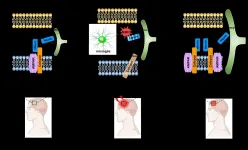(Press-News.org) (Vienna, Monday, 21 June, 2021) COVID-19 patients suffer from cognitive and behavioural problems two months after being discharged from hospital, a new study presented at the 7th Congress of the European Academy of Neurology (EAN) has found.
Issues with memory, spatial awareness and information processing problems were identified as possible overhangs from the virus in post-COVID-19 patients who were followed up within eight weeks.
The research also found that one in 5 patients reported post-traumatic stress disorder (PTSD), with 16% presenting depressive symptoms.
The study, conducted in Italy, involved testing neurocognitive abilities and taking MRI brain scans of patients two months after experiencing COVID-19 symptoms. More than 50% of patients experienced cognitive disturbances; 16%% had problems with executive function (governing working memory, flexible thinking, and information processing), 6% experienced visuospatial problems (difficulties judging depth and seeing contrast), 6% had impaired memory, and 25% manifested a combination of all these symptoms.
Cognitive and psychopathological problems were much worse in younger people, with the majority of patients aged under 50 demonstrating issues with executive functions.
In the whole sample, the greater severity of COVID-19 acute respiratory symptoms during hospital admission was associated with low executive function performance.
Additionally, a longitudinal observation of the same cohort at 10 months from COVID-19, showed a reduction of cognitive disturbances from 53 to 36%, but a persisting presence of PTSD and depressive symptoms.
Lead author of the study, Prof. Massimo Filippi, from the Scientific Institute and University Vita-Salute San Raffaele, Milan, Italy, explained, "Our study has confirmed significant cognitive and behavioural problems are associated with COVID-19 and persist several months after remission of the disease."
"A particularly alarming finding is the changes to executive function we found, which can make it difficult for people to concentrate, plan, think flexibly and remember things. These symptoms affected three in 4 younger patients who were of a working age".
No significant relationship was observed between cognitive performance and brain volume within the study.
"Larger studies and longer-term follow up are both needed, but this study suggests that COVID-19 is associated with significant cognitive and psychopathological problems", concluded Dr Canu, Researcher at the San Raffaele Hospital of Milan and first author of the study. "Appropriate follow-up and treatments are crucial to ensure these previously hospitalised patients are given adequate support to help to alleviate these symptoms."
Other COVID-19 findings at the 7th EAN Congress:
The study is one of four scientific presentations on the neurological symptoms of COVID-19, an area of research that is fast emerging, from this week's EAN Congress:
Research, led by Dr Mattia Pozzato of the Osperdale Maggiore Policlinico in Milan, found 77.4% of 53 patients reported developing at least one neurological symptom and 46.3% presented with more than three neurological symptoms between 5-10 months after being hospitalised with COVID-19. The most common of these symptoms were insomnia (65.9%), daytime sleepiness (46.3 %), and walking difficulties. Other less frequent symptoms included headaches, hyposmia (a reduced ability to smell) and hypogeusia (loss of taste). The authors concluded 90% of patients had post-COVID-19 symptoms, and that neurological symptoms form a significant part of these.
A research project presented by Professor Tamara S. Mischenko, Head of the Department of Neurology and Medical psychology at Karazin University, Ukraine, followed up 42 patients aged 32 to 54 after being hospitalised with COVID-19 after 2 to 4 months, finding that 95% had neurocognitive impairment symptom. All patients suffered from asthenic symptoms, increased fatigue, and anxiety/depression symptoms. Other symptoms included vestibular (balance) disorders, (59.2%), headaches, (50%) and reduced ability to smell (19%). Five patients also suffered ischaemic strokes in the two months after hospitalisation from COVID-19.
A study which looked at brain stem damage in COVID-19 patients from post-mortems showed a high percentage of neuronal damage and a higher number of small masses (called corpora amylacea) which are abundant in neurodegenerative diseases. Immunohistochemistry tests also revealed the presence of the virus in the brain stem. Measurements were compared with non-COVID-19 ICU patients. The author, Dr Tommaso Bocci, a neurologist and neurophysiologist at the University of Milan's Department of Neurological Science, said the study provides the first neuropathological, neurophysiological, and clinical evidence of the COVID-19-related brain stem involvement, especially at the medullary level, suggesting a neurogenic component of respiratory failure.
INFORMATION:
Notes to Editors:
Press Enquiries:
A reference to the 7th EAN Congress must be included when communicating the information within this press release.
For further information or to speak to an expert, please contact Luke Paskins or Sean Deans at press@ean.org or call +44 (0) 20 8154 6396.
About the Expert:
Professor Massimo Filippi is from the Scientific Institute and University Vita-Salute San Raffaele, Milan, Italy.
Dr Elisa Canu is from the San Raffaele Hospital, Milan, Italy.
EAN - The Home of Neurology:
The European Academy of Neurology (EAN) is Europe's home of neurology. Founded in 2014, through the merger of two European neurological societies, EAN represents the interests of more than 45,000 individual members and 47 national institutional members from across the continent.
EAN welcomes the interest of press in neurological issues and provides assistance to journalists attending the congress, or using the EAN website as a resource in their coverage, with pleasure.
As the number of lives affected by the COVID-19 pandemic has now reached the millions, the health and safety of our congress attendees, our patients and our families, remains our primary concern.
With this in mind, EAN decided to go virtual again for the 7th EAN Congress on June 19-22, 2021.
References:
1. Cognitive and behaviorial features of a cohort of patients in COVID-19 post-acute phase. Presented at the 7th EAN Congress 2021.
The first global standards to embed health and wellbeing into the education system have been created amid a rise in mental health problems during the COVID-19 pandemic.
Researchers at the Centre for Adolescent Health at the Murdoch Children's Research Institute (MCRI) led the two-year project at the invitation of the World Health Organization (WHO) and the United Nations Educational, Scientific and Cultural Organization (UNESCO). The two reports, to be launched this week in Geneva, provide a benchmarking framework to support the implementation of 'health promoting schools,' which aim to equally foster health ...
Washington, DC - June 20, 2021 - Researchers from Yonsei University in South Korea have found that certain commensal bacteria that reside in the human intestine produce compounds that inhibit SARS-CoV-2. The research will be presented on June 20 at World Microbe Forum, an online meeting of the American Society for Microbiology (ASM), the Federation of European Microbiological Societies (FEMS), and several other societies that will take place online June 20-24.
Previous clinical findings have shown that some patients with moderate to severe COVID-19 have gastro-intestinal symptoms, while others showed signs of infection solely in the lungs.
"We wondered whether gut ...
Washington, D.C. - June 20, 2021 - Increased screen time among young adults during the COVID-19 pandemic correlated with a rise in pandemic-related distress, according to research led by investigators at the Saint James School of Medicine on the Caribbean island nation, Saint Vincent. The increase in time spent viewing entertainment on a screen both prior to and during the pandemic was associated with a boost in anxiety scores. Students scored higher than non-students in pandemic-related distress. Surprisingly, the results showed no association of depression with screen ...
Washington, DC - June 20, 2021 - Researchers from the Miami University in Ohio have optimized a new technique that will allow scientists to evaluate how potential inhibitors work on antibiotic-resistant bacteria. This technique, called native state mass spectrometry, provides a quick way for scientists to identify the best candidates for effective clinical drugs, particularly in cases where bacteria can no longer be treated with antibiotics alone. This research will be presented at the American Society for Microbiology World Microbe Forum online conference on June 21, 2021.
Overuse of antibiotics in the last century has led to a rise in bacterial resistance, leading to many bacterial infections that are no longer treatable with current antibiotics. In the United States each year, 2.8 million ...
Washington, D.C. - June 20, 2021 - Although two SARS-CoV-2 variants are associated with higher transmission, patients with these variants show no evidence of higher viral loads in their upper respiratory tracts compared to the control group, a Johns Hopkins School of Medicine study found.
The emergence and higher transmission of the evolving variants of SARS-CoV-2, the virus that causes COVID-19, has been concerning. The researchers investigated B.1.1.7, the variant first identified in the UK, and B.1.351, the variant first identified in South Africa, to evaluate if patients showed higher ...
(Vienna, Sunday, 20 June, 2021) Women who suffer from migraines are more likely to endure obstetric and postnatal complications, a study presented today at the 7th Congress of the European Academy of Neurology (EAN) has found.
Pregnant women with migraines had a higher risk of developing obstetric and post partum complications. Migraine pregnant women had increased risk of been admitted to high-risk departments- 6% in non-migraine pregnant women, 6.9% in migraine without aura and 8.7% in pregnant women who suffer from migraine with aura.
Pregnant migraine patients had significantly increased risk of gestational diagnosis ...
Historically, shared resources such as forests, fishery stocks, and pasture lands have often been managed with an aim toward averting "tragedies of the commons," which are thought to result from selfish overuse. Writing in BioScience (https://academic.oup.com/bioscience/article-lookup/doi/10.1093/biosci/biab052), Drs. Senay Yitbarek (University of North Carolina at Chapel Hill), Karen Bailey (University of Colorado Boulder), Nyeema Harris (University of Michigan), and colleagues critique this model, arguing that, all too often, such conservation has failed to acknowledge ...
Cardiac surgeons may be able to better plan operations and improve their surgical field view with the help of a robot. Controlled through a virtual reality parallel system as a digital twin, the robot can accurately image a patient through ultrasound without the hand cramping or radiation exposure that hinder human operators. The international research team published their method in IEEE/CAA Journal of Automatica Sinica.
"Intra-operative ultrasound is especially useful, as it can guide the surgery by providing real-time images of otherwise hidden devices and anatomy," said paper author Fei-Yue Wang, Director of the State Key Laboratory of Management and Control of ...
Patients with brain injury (caused by stroke or trauma) primarily rely on rehabilitation therapy for recovery, as there are no other known effective treatment methods. The rate of recovery from brain injury observed in adults is significantly slower (or the recovery is impossible) than that observed in young children. The consensus among researchers is that the number of excess neural stem cells capable of restoring brain functions is lower in a mature brain than that in the brain of young children.
A Korean research team reported a novel mechanism to describe the brain injury recovery process. The researchers reported that when the animal model experiment was conducted, the time taken to recover from a brain injury could be controlled by ...
Globally, an estimated 10 million people develop tuberculosis (TB) each year and the disease remains a leading cause of death from a single infectious agent. Standard short-course anti-TB treatment still requires a regimen of at least six months of antimicrobial drugs, and drug-resistant TB is an increasing public health threat. Even after the traces of TB disease are quashed, patients often suffer from significant sequelae, such as lung scarring. TB survivors have approximately three to four times greater mortality than their local population.
In pulmonary TB, the most common form of active TB disease, the ...

